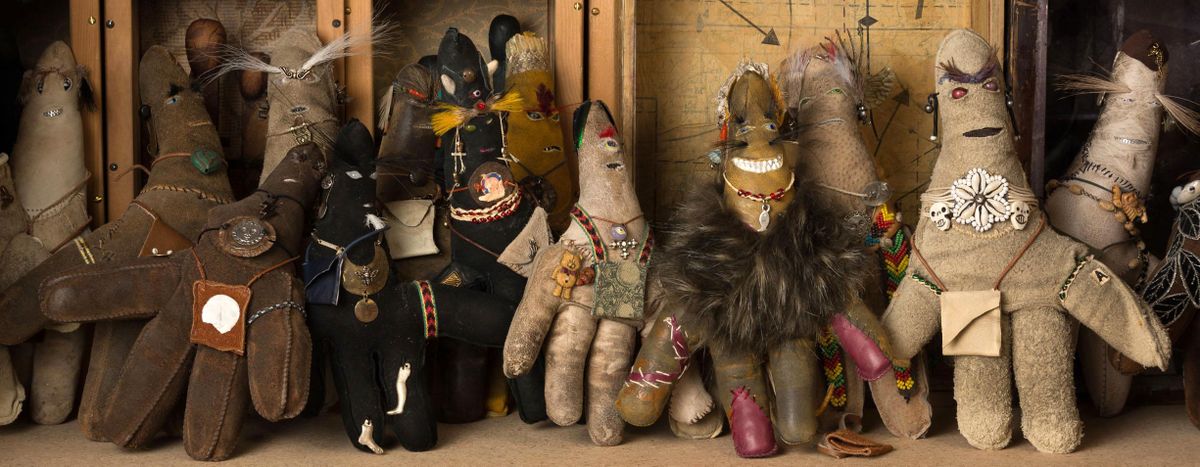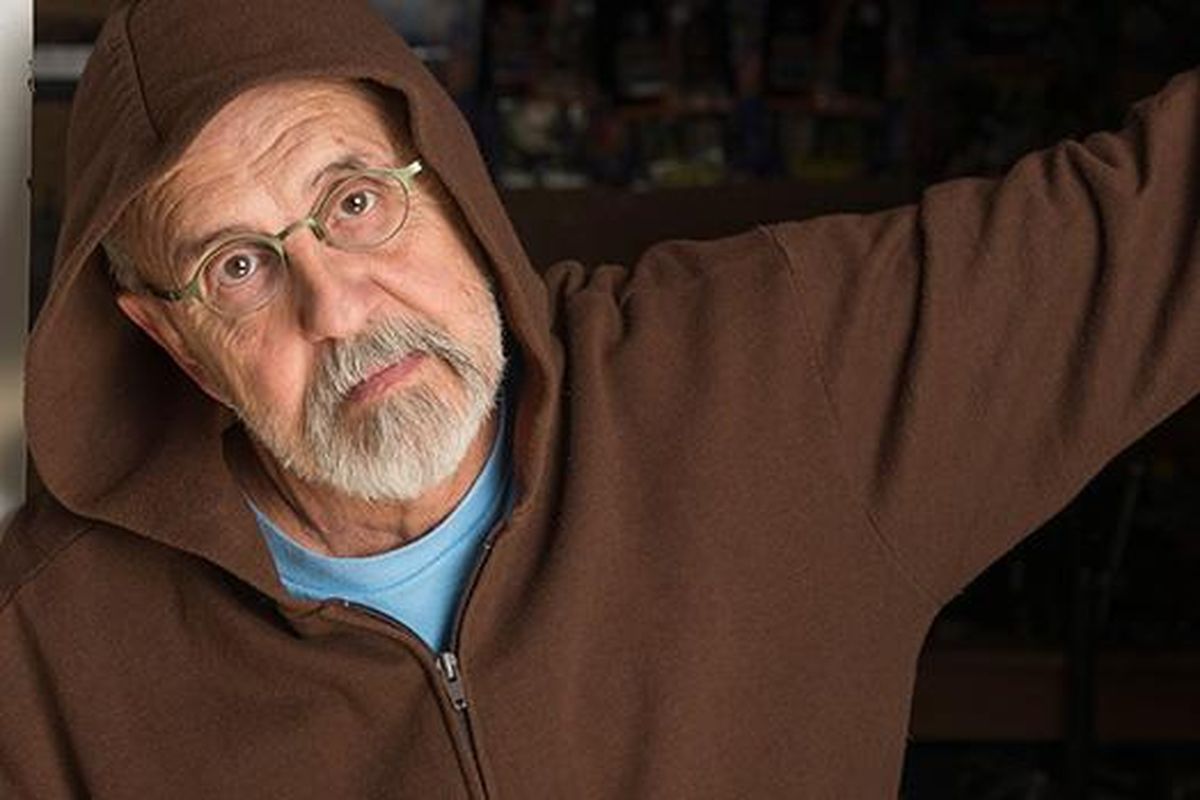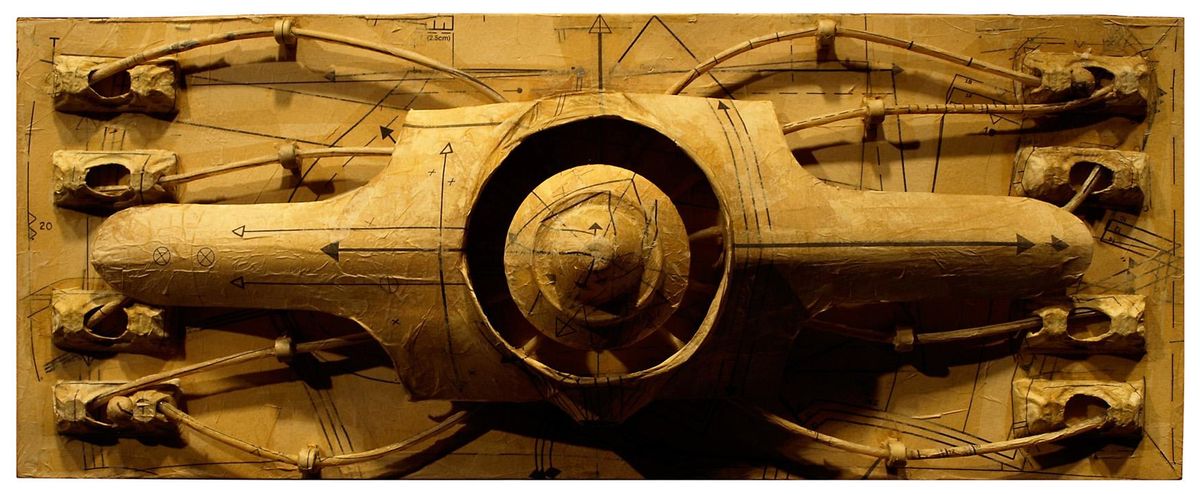Artist Dan McCann’s assemblages subject of EWU retrospective “A Look Back”
Dan McCann (Jon Lepper)
The basement of artist Dan McCann’s Perry District home is a collector’s dream. It’s a curated mash-up of some of the best and weirdest that pop culture has offered since the 1970s.
Among the rows of little dolls, robots, Rose Tea Co. figurines, Hello Kitties, monsters from “Alien” movies, and “Star Wars” and “Lord of the Rings” characters are hundreds of vinyl record albums and music CDs.
“I have a very selective set of records. It’s very clean,” McCann said. “There’s not a lot of junk in it.”
His taste is eclectic, ranging from the Rolling Stones, Sonic Youth and Lou Reed to the avant garde composer John Cage and the 1973 soundtrack to the animated sci-fi masterpiece “La Planète Sauvage.”
Clad in a hole-riddled cardigan handed down by his late father-in-law, McCann gleefully recounted where he unearthed a few of the thousands of treasures and art supplies he has discovered over the years.
“I got the Fantastic Planet at the (KPBX) record sale. I had the counterfeit, but this is the original,” McCann gushed. “And look, I have a videotape of the film. I just walked into Goodwill for that one.”
McCann’s own works of art are also curated collections of sorts. He assembles objects for display, placing them inside shadow boxes that he encloses with glass fronts. Inside the boxes are three-dimensional worlds, or arrangements of McCann’s making. His mini-universes and tableaux are sometimes pleasant, often frightening, and almost always strange.
“I call it arbitrary order,” McCann said. “I take arbitrary objects and make order out of them.”
Spokane’s most well-known assemblage artist currently has a retrospective, “Dan McCann: A Look Back,” on exhibit at the Eastern Washington University Gallery of Art through April 27.
When EWU Art Gallery Director Nancy Hathaway was presented with the opportunity to exhibit a local artist, McCann was at the top of her list.
“Dan McCann’s intuitive method of working, coupled with his use of found materials, results in works that run the gamut from serious and profound to weird and witty,” Hathaway said.
Among these strange and humorous pieces on display at EWU are “Tools of the Trade,” an open antique case of manmade objects that appear to be a set of tools. The mystery is what lost civilization buried these tools? For what purpose could anyone possibly use these seemingly foreign instruments?
For his “Joseph/Joseph” piece, McCann covered a box with felt, and inside he put together a parrot, a broken wine glass and a vial of fat. The arrangement references two iconic artists: Joseph Cornell and Joseph Beuys. Cornell, considered the godfather of assemblage art, often used aviary in his boxes. Beuys, famous for his happenings and performance pieces, frequently incorporated animal fat and felt cloth into his art as part of a mythical background he fashioned for himself.
Spending time with McCann is like walking through a fine arts library and a thrift shop at the same time.
McCann veered away from his boxes with a set of tribal dolls he created called “Danny Dolls.” He sewed them together from old leather gloves he found lost in the streets of Spokane. He picks up discarded items and plops them into the basket of his bike during his commute to his custodial job at Nordstrom in Spokane and the Nordstrom Rack in the Valley..
“I read that Tom Hanks takes photos of lost gloves he sees in the streets,” McCann said. “I fantasize calling him to offer him a doll for $300.”
McCann is a self-taught artist, the son of a Navy veteran who was born in Seattle, but grew up in Torrance, California. As an adult, he moved to his father’s hometown of Spokane and worked as a stained and fused glass artisan. McCann found his true calling for assemblage art after visiting Washington, D.C., in the 1980s. While his wife attended a conference for her work with the Catholic Church, McCann happened to catch an exhibition of boxes by Cornell.
“It did strike me like a thunderbolt,” McCann said. “Cornell brought box art into the fine arts field, and I thought it was amazing.”
Spokane Arts Commission member Dean Davis of Dean Davis Photography first became familiar with McCann when he bought a piece of his at a Northwest Museum of Arts and Culture Auction in 2008. The 8-by-18-inch box is called “A Place No One Should Go.” Inside the box McCann arranged a bald doll head in a room filled with loose sequins and suspended wires.
“I like Dan’s work because it’s a little odd. Maybe a lot odd,” Davis said. “That piece has a dark, foreboding feel to it.”
Davis bought three more pieces and ended up exhibiting McCann’s show “This, That & BRIC-a-BRAC” at his art gallery in 2010. But not everybody rushes to acquire McCann’s mixed media boxes. “Some people prefer pretty landscapes,” Davis said.
McCann accepts that his art is not to everyone’s taste.
“I think I’m kind of an artist’s artist,” McCann said. “I would love to sell more, but I’ve also hit a point where if you like my art, ‘Great!’ and ‘Thank you!’ And if you don’t like it, and you don’t get it, then ‘OK.’ ”
The best thing about the EWU show for McCann has been confirmation of his recent decision to retire next month to devote himself to his art full time. He has worked at Nordstrom downtown for 25 years, cleaning at night, doing maintenance, and sometimes sales.
Upon leaving the artist’s studio, called Lower Level Art, this reporter spotted a tattoo under McCann’s patched-up sweater. On the inside of his forearm are inked the words “embrace the struggle.” The phrase is the retort McCann’s wife of 35 years would say to him whenever he complained about having to deal with the 50-foot vacuum cleaner cord at work.
“The tattoo refers to the struggle of this stupid vacuum cleaner, but it could mean any struggle we face in life,” McCann said. “You have to embrace it.”



